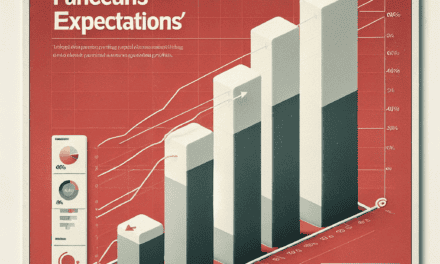“Dow Soars to New Heights as Tech Stumbles Under Inflation’s Weight”
Introduction
In a remarkable turn of events, the Dow Jones Industrial Average has surged past the 44,000 mark, setting a new milestone in the financial markets. This impressive rally comes even as technology stocks face significant headwinds, largely driven by mounting inflation concerns. Investors are increasingly shifting their focus towards more traditional sectors, seeking stability amid economic uncertainty. The divergence between the Dow’s robust performance and the faltering tech sector highlights the complex dynamics at play in the current economic landscape, as market participants navigate the challenges posed by rising prices and shifting monetary policies.
Dow’s Historic Surge: Breaking the 44,000 Barrier
The Dow Jones Industrial Average has recently achieved a historic milestone, surpassing the 44,000 mark for the first time in its history. This remarkable surge has captured the attention of investors and analysts alike, as it signifies a robust confidence in the broader market despite ongoing economic challenges. The Dow’s ascent can be attributed to a combination of factors, including strong corporate earnings, investor optimism, and a resilient economic recovery. However, this achievement comes at a time when tech stocks are experiencing a downturn, largely due to mounting inflation concerns that have cast a shadow over the sector.
To understand the dynamics behind the Dow’s impressive performance, it is essential to consider the broader economic context. The U.S. economy has been on a recovery trajectory following the disruptions caused by the COVID-19 pandemic. As businesses reopen and consumer spending rebounds, many companies have reported better-than-expected earnings, which has bolstered investor confidence. Additionally, sectors such as energy, financials, and industrials have shown significant strength, contributing to the Dow’s upward momentum. These sectors are often seen as more cyclical and tend to perform well during periods of economic expansion, further fueling the index’s rise.
In contrast, the technology sector, which has been a driving force behind market gains in recent years, is facing headwinds. Inflation concerns have led to increased volatility in tech stocks, as investors worry about the potential impact of rising prices on profit margins and future growth prospects. The Federal Reserve’s stance on interest rates has also played a role in this shift. As the central bank signals a possible tightening of monetary policy to combat inflation, tech stocks, which are often valued based on future earnings potential, have become less attractive to some investors. This has resulted in a rotation away from tech and into more traditional sectors, further propelling the Dow’s ascent.
Moreover, the divergence between the Dow and tech stocks highlights the market’s complex response to current economic conditions. While the Dow’s rise reflects optimism about the economic recovery, the tech sector’s struggles underscore the challenges posed by inflationary pressures. This dichotomy suggests that investors are recalibrating their portfolios to balance growth opportunities with risk management. As inflation remains a key concern, market participants are closely monitoring economic indicators and central bank communications for clues about future policy actions.
Despite the challenges facing tech stocks, it is important to note that the sector’s long-term growth potential remains intact. Technological innovation continues to drive transformative changes across industries, and companies that can adapt to the evolving landscape are likely to thrive. However, in the short term, the market’s focus on inflation and interest rates may continue to weigh on tech valuations.
In conclusion, the Dow’s historic surge past the 44,000 mark is a testament to the resilience of the U.S. economy and the strength of certain sectors. While tech stocks face pressure from inflation concerns, the broader market remains buoyant, reflecting a complex interplay of factors that investors must navigate. As the economic landscape continues to evolve, market participants will need to remain vigilant, balancing optimism with caution as they assess the opportunities and risks that lie ahead.
Inflation Woes: The Impact on Tech Stocks
As the Dow Jones Industrial Average recently surpassed the 44,000 mark, a milestone that reflects investor optimism in certain sectors of the economy, the technology sector has not shared in this buoyant sentiment. This divergence in market performance can be largely attributed to growing concerns over inflation, which have cast a shadow over tech stocks. Inflation, the rate at which the general level of prices for goods and services rises, erodes purchasing power and can lead to higher interest rates. These factors are particularly detrimental to technology companies, which often rely on future growth projections and are sensitive to changes in borrowing costs.
The technology sector, known for its rapid innovation and growth potential, has historically been a darling of investors. However, as inflationary pressures mount, the sector faces unique challenges. Higher inflation often prompts central banks to raise interest rates to cool down the economy. For tech companies, which frequently depend on borrowing to finance their expansion and research and development efforts, increased interest rates can lead to higher costs of capital. This, in turn, can dampen their growth prospects and make their stocks less attractive to investors seeking stable returns.
Moreover, inflation can impact consumer spending habits, which are crucial for tech companies that rely on consumer demand for their products and services. As prices rise, consumers may prioritize essential goods over discretionary spending, potentially leading to a decrease in demand for the latest gadgets and technological innovations. This shift in consumer behavior can further strain the revenue streams of tech companies, making it challenging for them to meet growth expectations.
In addition to these direct impacts, inflation can also lead to increased operational costs for tech companies. Rising prices for raw materials, components, and labor can squeeze profit margins, especially for companies that are unable to pass these costs onto consumers. This scenario is particularly concerning for tech firms that operate on thin margins or are in highly competitive markets where price increases could lead to a loss of market share.
While the broader market, as evidenced by the Dow’s impressive performance, seems to be weathering the inflation storm, the tech sector’s struggles highlight the uneven impact of economic conditions across different industries. Investors, therefore, are becoming more discerning, favoring sectors that are perceived as more resilient to inflationary pressures, such as financials and energy, over those that are more vulnerable, like technology.
Despite these challenges, it is important to note that the tech sector is not without its strengths. Many tech companies have strong balance sheets, significant cash reserves, and the ability to innovate and adapt to changing market conditions. These attributes may help them navigate the current inflationary environment and emerge stronger in the long term. Furthermore, the ongoing digital transformation across various industries continues to drive demand for technology solutions, providing a potential buffer against some of the negative impacts of inflation.
In conclusion, while the Dow’s rise past 44,000 is a testament to the resilience of certain sectors, the tech industry’s current struggles underscore the complexities of navigating an inflationary landscape. As inflation concerns persist, tech companies will need to strategically manage their costs, innovate to maintain consumer interest, and adapt to changing economic conditions to sustain their growth trajectories. Investors, meanwhile, will need to carefully assess the risks and opportunities within the tech sector, balancing short-term challenges with long-term potential.
Market Dynamics: Dow’s Rise Versus Tech’s Struggle
The financial markets have recently witnessed a significant divergence in performance, with the Dow Jones Industrial Average surpassing the 44,000 mark, while technology stocks have struggled amid growing inflation concerns. This development highlights the complex dynamics at play in the current economic environment, where traditional industries appear to be gaining favor over their tech counterparts. As investors navigate these shifting tides, understanding the underlying factors driving these trends becomes crucial.
To begin with, the Dow’s impressive ascent can be attributed to several key factors. Primarily, the index’s composition, which includes a diverse array of companies from various sectors such as finance, healthcare, and consumer goods, has provided a buffer against the volatility that has plagued the tech sector. Moreover, many of these companies have demonstrated resilience in the face of economic uncertainty, benefiting from stable demand and robust earnings reports. This stability has attracted investors seeking refuge from the turbulence affecting other parts of the market.
In contrast, technology stocks have faced a more challenging landscape. The sector, which has been a significant driver of market growth in recent years, is now grappling with the implications of rising inflation. As inflationary pressures mount, concerns about increased costs and potential interest rate hikes have weighed heavily on tech companies. These firms, often characterized by high valuations and growth expectations, are particularly sensitive to changes in the economic environment. Consequently, investors have become more cautious, leading to a pullback in tech stock prices.
Furthermore, the Federal Reserve’s monetary policy has played a pivotal role in shaping market dynamics. With inflation rates climbing, the central bank has signaled a potential shift towards tightening monetary policy, which could include raising interest rates. Such a move would likely increase borrowing costs, impacting tech companies that rely heavily on financing for expansion and innovation. This prospect has further fueled investor apprehension, contributing to the sector’s recent underperformance.
Additionally, the global supply chain disruptions have exacerbated the challenges faced by technology firms. The ongoing semiconductor shortage, for instance, has hindered production capabilities and delayed product launches, affecting revenue streams. As these supply chain issues persist, tech companies are forced to navigate an increasingly complex operational landscape, adding another layer of uncertainty to their financial outlook.
Despite these headwinds, it is essential to recognize that the tech sector’s long-term growth potential remains intact. Innovations in areas such as artificial intelligence, cloud computing, and renewable energy continue to drive technological advancements, offering promising opportunities for future expansion. However, in the short term, investors may need to exercise patience as the sector adjusts to the evolving economic conditions.
In conclusion, the current market dynamics underscore the importance of diversification and strategic asset allocation. While the Dow’s rise reflects the strength of traditional industries in the face of inflationary pressures, the tech sector’s struggles highlight the challenges posed by an uncertain economic environment. As investors seek to balance risk and reward, staying informed about these trends and their implications will be crucial in making sound investment decisions. Ultimately, the interplay between inflation, monetary policy, and sector-specific factors will continue to shape the financial landscape, requiring vigilance and adaptability from market participants.
Investment Strategies: Navigating a Shifting Market
The recent surge of the Dow Jones Industrial Average past the 44,000 mark has captured the attention of investors and analysts alike, marking a significant milestone in the financial markets. This achievement, however, comes at a time when tech stocks are experiencing a downturn, largely due to mounting inflation concerns. As investors navigate this shifting market landscape, it becomes crucial to reassess investment strategies to ensure they are well-positioned to capitalize on emerging opportunities while mitigating potential risks.
The Dow’s impressive performance can be attributed to several factors, including robust corporate earnings, increased consumer spending, and a resilient labor market. Traditional sectors such as finance, energy, and industrials have been the primary drivers of this growth, benefiting from the broader economic recovery. These sectors have shown remarkable resilience, adapting to the post-pandemic environment and capitalizing on increased demand. Consequently, investors have been reallocating their portfolios, favoring these sectors over the once-dominant technology stocks.
In contrast, the technology sector, which had been the darling of the market during the pandemic, is now facing headwinds. Rising inflation has led to concerns about higher interest rates, which can negatively impact tech companies that rely heavily on borrowing for growth and expansion. Additionally, supply chain disruptions and regulatory pressures have further compounded the challenges faced by tech firms. As a result, many investors are reevaluating their exposure to technology stocks, seeking to diversify their portfolios to reduce risk.
In light of these developments, a strategic approach to investment is essential. Diversification remains a key principle, allowing investors to spread risk across various asset classes and sectors. By doing so, they can potentially offset losses in one area with gains in another. For instance, while tech stocks may be underperforming, sectors such as energy and finance are thriving, offering attractive investment opportunities. Moreover, incorporating fixed-income securities, such as bonds, can provide stability and income, especially in a volatile market environment.
Another important consideration is the focus on value investing. As inflation concerns persist, companies with strong fundamentals, stable cash flows, and reasonable valuations are likely to be more resilient. Value stocks, often found in sectors like consumer goods, healthcare, and utilities, can offer a hedge against inflationary pressures. These companies tend to have pricing power, allowing them to pass on increased costs to consumers without significantly impacting demand.
Furthermore, investors should remain vigilant and informed about macroeconomic trends and policy changes. Central banks’ monetary policies, government fiscal measures, and geopolitical developments can all influence market dynamics. Staying abreast of these factors can help investors make informed decisions and adjust their strategies accordingly.
In conclusion, as the Dow surpasses 44,000 and tech stocks falter amid inflation concerns, investors are faced with a complex and evolving market landscape. By embracing diversification, focusing on value investing, and staying informed about broader economic trends, they can navigate these challenges effectively. While uncertainties remain, a well-considered investment strategy can help investors seize opportunities and achieve their financial goals in this shifting market environment.
Economic Indicators: What Dow’s Surge Means for Investors
The recent surge of the Dow Jones Industrial Average, surpassing the 44,000 mark, has captured the attention of investors and analysts alike. This milestone, while significant, comes at a time when tech stocks are experiencing a downturn, largely due to mounting inflation concerns. Understanding the implications of these contrasting trends is crucial for investors seeking to navigate the current economic landscape.
To begin with, the Dow’s impressive performance can be attributed to several factors. Traditional industries, such as manufacturing and energy, have shown resilience and growth, buoyed by increased consumer demand and government infrastructure spending. These sectors, which form a substantial part of the Dow, have benefited from the gradual reopening of economies worldwide and the subsequent rise in industrial activity. Moreover, the Dow’s composition, which leans heavily towards established companies with stable earnings, has provided a safe haven for investors wary of the volatility seen in other parts of the market.
In contrast, the technology sector, which has been a driving force behind market gains in recent years, is facing headwinds. Inflation concerns have led to fears of rising interest rates, which could increase borrowing costs and reduce profit margins for tech companies. Additionally, the tech sector’s high valuations have made it particularly vulnerable to shifts in investor sentiment. As a result, many investors are re-evaluating their portfolios, opting to reduce exposure to tech stocks in favor of more traditional, value-oriented investments.
The divergence between the Dow’s ascent and the tech sector’s struggles highlights a broader shift in market dynamics. Investors are increasingly focusing on companies with tangible assets and consistent cash flows, as opposed to those with high growth potential but uncertain profitability. This shift is reflective of a more cautious approach, as market participants weigh the potential impact of inflation on future earnings.
Furthermore, the Federal Reserve’s monetary policy plays a pivotal role in shaping investor expectations. While the Fed has maintained a relatively accommodative stance, signaling a gradual approach to interest rate hikes, any indication of a more aggressive tightening could exacerbate concerns about inflation and its impact on growth stocks. Consequently, investors are closely monitoring economic indicators and Fed communications for clues about the future direction of monetary policy.
In light of these developments, investors are advised to adopt a balanced approach to portfolio management. Diversification remains a key strategy, as it allows investors to mitigate risks associated with sector-specific downturns. By maintaining a mix of growth and value stocks, as well as considering alternative asset classes such as commodities and real estate, investors can better position themselves to weather market volatility.
In conclusion, the Dow’s surge past 44,000, juxtaposed with the tech sector’s faltering performance, underscores the complex interplay of factors influencing the current market environment. While traditional industries are experiencing a renaissance, driven by economic recovery and infrastructure investments, tech stocks are grappling with the challenges posed by inflation and interest rate uncertainties. As investors navigate these shifting dynamics, a prudent and diversified investment strategy will be essential in achieving long-term financial goals.
Tech Sector Challenges: Inflation and Market Volatility
The recent surge of the Dow Jones Industrial Average past the 44,000 mark has captured the attention of investors and analysts alike, marking a significant milestone in the financial markets. However, this achievement comes at a time when the technology sector is grappling with its own set of challenges, primarily driven by inflation concerns and market volatility. As the broader market celebrates the Dow’s ascent, tech stocks are experiencing a period of uncertainty, highlighting the complex dynamics at play in today’s economic landscape.
To begin with, the rise of the Dow can be attributed to a combination of factors, including strong corporate earnings, robust consumer spending, and a resilient labor market. These elements have collectively bolstered investor confidence, propelling the index to new heights. However, the technology sector, which has been a driving force behind market growth in recent years, is facing headwinds that are causing some investors to reassess their positions. Inflation, in particular, has emerged as a significant concern, as rising costs for goods and services threaten to erode profit margins and dampen consumer demand.
In this context, it is important to consider the impact of inflation on the technology sector. Tech companies, known for their rapid innovation and growth, often rely on complex supply chains and significant capital investments. As inflationary pressures mount, these companies may encounter increased costs for raw materials, labor, and transportation. Consequently, they may be forced to pass these costs onto consumers, potentially leading to reduced demand for their products and services. This scenario is particularly concerning for tech firms that operate on thin margins or are heavily reliant on consumer spending.
Moreover, the Federal Reserve’s response to inflation is another factor contributing to market volatility. As the central bank signals potential interest rate hikes to combat rising prices, investors are becoming increasingly cautious. Higher interest rates can lead to increased borrowing costs for companies, which may, in turn, slow down expansion plans and reduce profitability. For the technology sector, which often relies on external financing to fuel growth, this could pose a significant challenge. As a result, tech stocks have experienced heightened volatility, with some companies seeing sharp declines in their valuations.
Despite these challenges, it is essential to recognize that the technology sector remains a vital component of the global economy. Innovations in areas such as artificial intelligence, cloud computing, and renewable energy continue to drive progress and create new opportunities. However, navigating the current economic environment requires a strategic approach. Companies must focus on enhancing operational efficiency, managing costs, and diversifying revenue streams to mitigate the impact of inflation and interest rate fluctuations.
In conclusion, while the Dow’s impressive performance is a testament to the resilience of the broader market, the technology sector is facing a period of uncertainty driven by inflation concerns and market volatility. As investors weigh the risks and opportunities, it is crucial to adopt a balanced perspective that considers both the challenges and the potential for growth. By understanding the complex interplay of economic factors, stakeholders can make informed decisions that support long-term success in an ever-evolving financial landscape.
Future Outlook: Can Tech Stocks Rebound Amid Inflation?
As the Dow Jones Industrial Average recently surpassed the 44,000 mark, investors are left pondering the future trajectory of tech stocks, which have shown signs of faltering amid growing inflation concerns. This development has sparked a debate among market analysts and investors alike, as they assess whether tech stocks can rebound in the face of economic pressures. The juxtaposition of the Dow’s impressive performance against the backdrop of struggling tech stocks underscores the complexity of the current financial landscape.
To understand the potential for a tech stock rebound, it is essential to first examine the factors contributing to their recent decline. Inflation, a key concern for investors, has been on the rise, driven by a combination of supply chain disruptions, increased consumer demand, and expansive fiscal policies. As inflationary pressures mount, central banks around the world, including the Federal Reserve, have signaled potential interest rate hikes to curb inflation. Higher interest rates typically lead to increased borrowing costs, which can dampen corporate profits and, consequently, stock valuations. Tech companies, often characterized by high growth potential but also significant capital requirements, are particularly sensitive to such changes in the economic environment.
Moreover, the tech sector’s vulnerability to inflation is compounded by its reliance on global supply chains. The ongoing semiconductor shortage, for instance, has highlighted the fragility of these supply chains and their susceptibility to disruptions. As tech companies grapple with these challenges, their ability to maintain growth trajectories and meet investor expectations is called into question. This uncertainty has led to a reevaluation of tech stock valuations, contributing to their recent underperformance.
Despite these challenges, there are reasons to remain optimistic about the potential for a tech stock rebound. Historically, the tech sector has demonstrated resilience in the face of economic headwinds, driven by its capacity for innovation and adaptation. The rapid pace of technological advancement continues to create new opportunities for growth, from artificial intelligence and machine learning to renewable energy solutions and digital transformation initiatives. These innovations have the potential to drive productivity gains and create new markets, providing a foundation for future growth.
Furthermore, the long-term structural trends that have supported the tech sector’s rise remain intact. The digitalization of the global economy, accelerated by the COVID-19 pandemic, continues to drive demand for tech products and services. As businesses and consumers increasingly rely on digital solutions, tech companies are well-positioned to capitalize on this ongoing shift. Additionally, the growing emphasis on sustainability and environmental responsibility presents new opportunities for tech companies to develop innovative solutions that address these global challenges.
In conclusion, while the current economic environment presents significant challenges for tech stocks, their potential for a rebound should not be underestimated. The sector’s history of resilience, coupled with its capacity for innovation and the enduring structural trends supporting its growth, suggests that tech stocks may yet recover from their recent setbacks. As investors navigate this complex landscape, a balanced approach that considers both the risks and opportunities inherent in the tech sector will be crucial. Ultimately, the ability of tech stocks to rebound amid inflation concerns will depend on a combination of macroeconomic factors, company-specific strategies, and the sector’s continued capacity for innovation.
Q&A
1. **What milestone did the Dow Jones Industrial Average recently achieve?**
The Dow Jones Industrial Average recently surpassed the 44,000 mark.
2. **What sector is experiencing difficulties despite the Dow’s rise?**
The technology sector is faltering amid the Dow’s rise.
3. **What is the primary concern affecting tech stocks?**
Inflation concerns are the primary issue affecting tech stocks.
4. **How does inflation impact technology stocks specifically?**
Inflation can lead to higher interest rates, which often negatively impact growth stocks like those in the tech sector.
5. **What is the general market sentiment regarding inflation?**
There is concern and caution in the market regarding rising inflation and its potential impact on various sectors.
6. **Are there any specific tech companies mentioned as being affected?**
The question does not specify particular companies, but generally, major tech firms are implied to be affected.
7. **What might investors be considering in response to these market conditions?**
Investors might be considering reallocating their portfolios, possibly moving away from tech stocks towards more stable or inflation-resistant investments.
Conclusion
The Dow Jones Industrial Average surpassing 44,000 points marks a significant milestone, reflecting investor confidence in traditional industries and sectors that comprise the index. This achievement comes despite the faltering of tech stocks, which have been under pressure due to rising inflation concerns. Inflation can lead to higher interest rates, which often negatively impact tech companies that rely on future growth and earnings. The divergence between the Dow’s performance and the tech sector highlights a shift in investor sentiment, favoring value and cyclical stocks over growth-oriented tech stocks. This trend suggests a potential reallocation of capital as investors seek stability and hedge against inflationary pressures.





